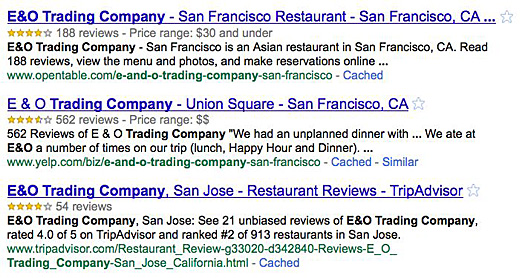
An example of Google Rich Snippets.
 The Semantic Web is a big step toward Web 3.0, where the ultimate goal is to make Web content more machine-friendly and thus, in turn, more useful to humans.
The Semantic Web is a big step toward Web 3.0, where the ultimate goal is to make Web content more machine-friendly and thus, in turn, more useful to humans.
Most websites are produced using HTML, which is a markup language used to make a website “look” a certain way. The Semantic Web, on the other hand, is based on markup languages that focus on tagging the content by what it “means.”
A more “semantic” Internet will allow search engines to produce more relevant results because the searched content will be “marked up” in such a way that the engines (machines) can make better sense of it.
The Semantic Web is not AI (artificial intelligence), as some people seem to think. It is about making the content easier for machines to interpret, not about making the machines themselves smarter. Two ways in which this is accomplished is through structured data and linked data.
Structured data: Making it easier to share information
You can prepare your content in a way that will help search engines include it in very relevant search results. For instance, you can offer ways for your contact information, products or reviews to show up directly in a Google or Yahoo search result by adding a few tags to your content that will transform it into what is called “structured data.”
Contact and location information, events, products and reviews are all perfect types of structured data and can be tagged in standard formats called “markup formats” to make it easy for search engines to recognize them as such.
Structured data has been around for some time, waiting in the wings for the search engines to take it seriously. In 2009, Google introduced “Rich Snippets,” a feature that recognizes markup formats and displays the content in your search listing accordingly. See the image at top for an example.
Google is supporting the two most standard markup formats: Microformats and RDFa. Both of these standard formats are very straightforward. Anyone with experience building a website or using a content management system like WordPress can easily use them to mark up their existing Web content as structured data.
Linked data: Create apps from rich datasets
Linked Data also refers to a way of structuring data, but it does so by using the Web to create links between data from many different datasets and classifies it using an established data commons.
By using a common reference to represent a piece of data, that data can be linked easily to and from other sources of data, creating what is referred to as a “Web of Data.”
The most impressive of these Webs of Data is the Linked Open Data (LOD) cloud. In the center of this “cloud” (only a small part of it) is “Dbpedia,” which is the dataset that feeds Wikipedia.

The resulting “Web of Data” can be accessed by semantic Web browsers that navigate between different data sources, similar to how traditional Web browsers navigate between HTML pages.
One of the things that make Linked Data so powerful is what one can do with the data once it is linked. Given the right tools and know-how, anyone can draw from this tremendous resource to create powerful applications.
Cross-posted to Technorati.Deltina Hay, a partner in Socialmedia.biz, is an author and educator who develops online curricula on social media and other Internet marketing topics. She also helps businesses prepare their content for semantic search and big data analysis. Contact her, follow her on Twitter and Google Plus, or leave a comment below.
Thank you! This is the first coherent (human-friendly) explanation I've seen.
Thanks, Rosemary. Glad it helped! I really do try to write for “everybody.”
Ah, another techie stuff made simple for the rest of us who are clueless. I'd say thanks for taking the time to explain things here. Now, I wonder whatever happened to 'Web of Intent' where people control what they want to access online and internet is simply dead. We're all connected, I guess.
Slight correction though – DBpedia doesn't feed Wikipedia. DBpedia is built from spidering the infoboxes on Wikipedia.